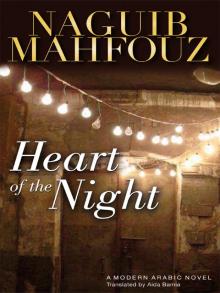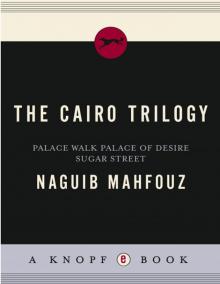- Home
- Naguib Mahfouz
The Time and the Place: And Other Stories
The Time and the Place: And Other Stories Read online
AN ANCHOR BOOK
PUBLISHED BY DOUBLEDAY
a division of Bantam Doubleday Dell Publishing Group, Inc.
1540 Broadway, New York, New York 10036
ANCHOR BOOKS, DOUBLEDAY, and the portrayal of an anchor are trademarks of Doubleday, a division of Bantam Doubleday Dell Publishing Group, Inc.
The Time and the Place was originally published in hardcover by Doubleday in 1991. The Anchor Books edition is published by arrangement with Doubleday.
Arabic text sources for the stories in this volume are as follows:
“Zaabalawi,” as “Za‘balawi,” and “By a Person Unknown,” as “Didd Majhul,” in Dunya Allah (God’s World), Cairo, Maktabat Misr, 1962; “The Conjurer Made Off with the Dish,” as “al-Hawi khataf al-tabaq,” and “At the Bus Stop,” as “Tahta al-mizalla,” in Tahta al-mizalla (Under the Shelter), Cairo, Maktabat Misr, 1969; “The Answer Is No,” as “ ‘Indama yaqul al-bulbul la,” “Half a Day,” as “Nisf yawm,” “The Lawsuit,” as “al-Qadiya,” “A Day for Saying Goodbye,” as “Yawm al-wida‘,” “His Majesty,” as “Mawlana,” and “A Long-Term Plan,” as “Khitta ba‘idat almada,” in al-Fajr al-kadhib (The False Dawn), Cairo, Maktabat Misr, 1989; “The Time and the Place,” as “al-‘Ain waal-sa’a,” “Blessed Night,” as “al-Layla al-mubaraka,” in Ra’aytu fi ma yarn al-na’im (I Saw in My Dreams), Cairo, Maktabat Misr, 1982; “The Ditch,” as “al-Khandaq,” and “The Norwegian Rat,” as “al-Fa’r al-norwiji,” in al-Tanzim al-sirri (The Secret Organization), Cairo, Maktabat Misr, 1984; “The Tavern of the Black Cat,” as “Khammarat al-qitt al-aswad,” and “The Wasteland,” as “al-Khala’,” in Khammarat al-qitt al-aswad (The Tavern of the Black Cat), Cairo, Maktabat Misr, 1969; “The Empty Café,” as “al-Qahwa al-khaliya,” “Fear,” as “al-Khawf,” “A Fugitive from Justice,” as “al-Harib min al-i’dam,” in Bayt sayyi’ al-sum’a (House with a Bad Name), Cairo, Maktabat Misr, 1965; “The Man and the Other Man,” as “al-Rajul wa-al-akhar,” in al-Hubb fawqa hadabat al-haram (Love on the Pyramid Hill), Cairo, Maktabat Misr, 1979.
“Zaabalawi” was previously published in the U.S. in this English translation in Modern Arabic Short Stories, Three Continents Press, 1981.
“The Conjurer Made Off with the Dish” was previously published in the U.S. in this English translation in Egyptian Short Stories, Three Continents Press, 1978.
These translations are published by arrangement with The American University in Cairo Press.
All of the characters in this book are fictitious, and any resemblance to actual persons, living or dead, is purely coincidental.
Library of Congress Cataloging-in-Publication Data
Mahfüz, Najīb, 1912–
The time and the place and other stories / Naguib Mahfouz : selected and translated by Denys Johnson-Davies.
p. cm.
I. Johnson-Davies, Denys. II. Title.
PJ7846.A46A25 1992
892′.736—dc20
92-7031
ISBN 9780385264723
eBook ISBN 9780525431633
Copyright © 1991 by the American University in Cairo Press
Arabic texts copyright © 1962, 1965, 1969, 1979, 1982, 1984, 1989
by Naguib Mahfouz
The English translations of “Zaabalawi” copyright © 1967 and “The Conjurer Made Off with the Dish” copyright © 1978 by Denys Johnson-Davies
ALL RIGHTS RESERVED
v4.1
a
Contents
Cover
Title Page
Copyright
Introduction by Denys Johnson-Davies
Zaabalawi
The Conjurer Made Off with the Dish
The Answer Is No
The Time and the Place
Blessed Night
The Ditch
Half a Day
The Tavern of the Black Cat
The Lawsuit
The Empty Café
A Day for Saying Goodbye
By a Person Unknown
The Man and the Other Man
The Wasteland
The Norwegian Rat
His Majesty
Fear
At the Bus Stop
A Fugitive from Justice
A Long-Term Plan
About the Author
About the Translator
Books by Naguib Mahfouz
Introduction
It is of course as a novelist that Naguib Mahfouz is best known. His output in that field, nearly forty books, is by any standard formidable and inevitably overshadows his accomplishments as a writer of short stories. And yet his fourteen volumes of short stories contain some of the best in modern Arabic literature—and it is the short story which, in the Arab world, has been the preferred genre since the first attempts at writing fiction in Arabic were made early in this century. (Let us ignore here the fact that one of the world’s greatest masterpieces of fiction, A Thousand and One Nights, was composed in Arabic.) Short stories by Naguib Mahfouz have appeared in translation in many languages, and it is interesting to find, in a collection such as The Art of the Tale (Penguin, 1986), alongside the work of such authors as Borges, Beckett, Camus, Greene, and Marquez, a single example from the Arab world—a story by Naguib Mahfouz, and this before he had been awarded the Nobel Prize. The story chosen is “The Conjurer Made Off with the Dish,” which had previously been published in a collection of stories by Egyptian writers and is included in the present volume. Of the remaining nineteen stories in this volume, all but three are appearing in English for the first time.
Naguib Mahfouz is essentially an Egyptian writer. Born in 1911 in Gamaliyya, one of Cairo’s most picturesque districts, he has spent his life in that city and moves from it only once a year, to spend the hot summer months in seaside Alexandria. Only twice in his life has he been abroad, and after his second trip he vowed never to travel again. His writings, almost without exception, are placed in Cairo; in the present collection only “A Day for Saying Goodbye” has another setting—Alexandria. Like their author, his stories never travel abroad, not even to the Egyptian countryside with its peasant life, which has been such fertile soil for most Egyptian writers. A predominance of his novels and stories are sited in that square mile or so which makes up the districts of Gamaliyya and al-Hussein, an area which includes that vast bazaar known to tourists as Khan al-Khalili, with its numerous mosques, cafés, small shops, and jostling motley of colorful characters.
Stories like “Fear” and “The Wasteland” take place in the dark narrow alleyways of bustling activity where fitiwwat—“toughs,” the bosses of small gangs—contend for control of some area of a quarter and exploit it to their advantage. (Today the fitiwwat, like the gangsters of the days of Prohibition, are a thing of the past.) Both these early stories also show Naguib Mahfouz’s preoccupation with time—he has cited Proust as one of his main literary influences. In “The Wasteland” the protagonist’s single-minded efforts are rendered meaningless by his failure to take account of the fact that, for others as much as for himself, time accompanies people on their journey through life. In “Fear,” too, by the end of the story time has stolen the bloom of youth from Na’ima’s cheeks and has given the dashing young police officer a paunch. “The Empty Café” tells of the loneliness of old age: a long life, as the old man says, is a curse. It is as though he no longer belongs to the human race, having outstripped all his contemporaries, and ends by hoping to find companionship in another species, the cat belonging to his young, over-rambunctious grandson. “A Long-Term Plan” reminds us that nothing in life is right unless its timing is right, no good luck so futile as when it come
s at the wrong time. Most moving of all the stories concerned with time is the short “Half a Day,” where time is telescoped into the morning’s walk, the first day at school, and the return journey home. It is a gentle story tinged with nostalgia for time irrecoverable.
In the West, as religion becomes increasingly a social function or merely part of the cultural background, many people like to think that, helped by such institutions as insurance companies, they are masters of their fate. The East, particularly the Islamic East, knows better. The Koran tells the Muslim that a person’s life span lies in God’s hands, emphasizing that every soul must taste death. Not surprisingly, death plays a leading role in the lives of the characters that people Naguib Mahfouz’s writings.
The period from 1967 to 1971, following Egypt’s disastrous 1967 war with Israel, was a bad one for Mahfouz. During those dark years he gave up writing novels and turned to the short story. In many of the stories he wrote during this time—among his best and blackest—death is central. Referring to these stories, he has remarked that he could never conquer the idea of dying until he wrote about it. Stories like “At the Bus Stop” are as bleakly pessimistic as anything he has written. “A Fugitive from Justice” contains a very short scene, quite extraneous to the events of the story, in which the funeral procession of a young girl prompts one of the protagonists to observe: “Isn’t it the road we all take?” Such reminders crop up often in Mahfouz’s stories.
In “The Man and the Other Man,” the world is described as being subject to many laws, not just one—and several of the stories in this volume inhabit that gray area that lies behind the façade of comfortable reality. “Zaabalawi,” for instance, introduces us to a world of uncertainty, frustration, and contradiction, a world inspired by Sufism, Islam’s particular brand of mysticism, in whose rich literature Naguib Mahfouz is deeply read. In “The Time and the Place,” the author, with great deftness, creates a Thousand-and-One-Nights atmosphere and prepares his reader for—and makes credible—happenings that can only be explained in terms of some super-natural law. All this he does with a remarkable economy of words. This ability to be brief and explicit Mahfouz ascribes to the many film scenarios he has written during his career.
Modern Arabic literature as a whole contains little humor, though the Egyptians especially are noted for their wit and their habit of making fun of their circumstances and, in particular, of their leaders. Some of this dry humor is to be found in “The Norwegian Rat,” as well as in “The Ditch,” which deals with the economic tribulations of middle-class Egyptians living in a society crippled by inflation and suffering such an acute housing shortage that many have in desperation taken up residence in the family mausoleums in the “City of the Dead.”
The slight and somewhat uncharacteristic story “The Answer Is No” is Naguib Mahfouz’s most recent. At the time he was awarded the Nobel Prize, an Egyptian weekly asked him for any recent story that was as yet unpublished, and he sent them this one. What is remarkable about it is that, written by a man of his generation, it should be so outspokenly feminist. For the Western reader it provides an insight into how different Eastern societies are in respect of sexual mores, even a country as modern-minded as Egypt. A Western reader might well ask, “What’s all the fuss about?” Naguib Mahfouz, as an Egyptian, knows what the fuss is about but makes it clear where his own sympathies lie.
It was in 1934, the year in which he graduated in philosophy from Cairo University, that Mahfouz saw published his first piece of original writing—a short story. At that time, he would send his stories to magazines and be delighted if they appeared in print. He recounts how one day an editor asked him to call round at his office. He did so and was handed a pound for his latest story. “One gets paid for them as well!” exclaimed the budding writer in disbelief—and it was with the same modest disbelief that, more than half a century later, he received the news of the Nobel Prize.
DENYS JOHNSON-DAVIES
Zaabalawi
Finally I became convinced that I had to find Sheikh Zaabalawi.
The first time I had heard his name had been in a song:
Oh what’s become of the world, Zaabalawi?
They’ve turned it upside down and taken away its taste.
It had been a popular song in my childhood, and one day it had occurred to me to demand of my father, in the way children have of asking endless questions:
“Who is Zaabalawi?”
He had looked at me hesitantly as though doubting my ability to understand the answer. However, he had replied, “May his blessing descend upon you, he’s a true saint of God, a remover of worries and troubles. Were it not for him I would have died miserably—”
In the years that followed, I heard my father many a time sing the praises of this good saint and speak of the miracles he performed. The days passed and brought with them many illnesses, for each one of which I was able, without too much trouble and at a cost I could afford, to find a cure, until I became afflicted with that illness for which no one possesses a remedy. When I had tried everything in vain and was overcome by despair, I remembered by chance what I had heard in my childhood: Why, I asked myself, should I not seek out Sheikh Zaabalawi? I recollected my father saying that he had made his acquaintance in Khan Gaafar at the house of Sheikh Qamar, one of those sheikhs who practiced law in the religious courts, and so I took myself off to his house. Wishing to make sure that he was still living there, I made inquiries of a vendor of beans whom I found in the lower part of the house.
“Sheikh Qamar!” he said, looking at me in amazement. “He left the quarter ages ago. They say he’s now living in Garden City and has his office in al-Azhar Square.”
I looked up the office address in the telephone book and immediately set off to the Chamber of Commerce Building, where it was located. On asking to see Sheikh Qamar, I was ushered into a room just as a beautiful woman with a most intoxicating perfume was leaving it. The man received me with a smile and motioned me toward a fine leather-upholstered chair. Despite the thick soles of my shoes, my feet were conscious of the lushness of the costly carpet. The man wore a lounge suit and was smoking a cigar; his manner of sitting was that of someone well satisfied both with himself and with his worldly possessions. The look of warm welcome he gave me left no doubt in my mind that he thought me a prospective client, and I felt acutely embarrassed at encroaching upon his valuable time.
“Welcome!” he said, prompting me to speak.
“I am the son of your old friend Sheikh Ali al-Tatawi,” I answered so as to put an end to my equivocal position.
A certain languor was apparent in the glance he cast at me; the languor was not total in that he had not as yet lost all hope in me.
“God rest his soul,” he said. “He was a fine man.”
The very pain that had driven me to go there now prevailed upon me to stay.
“He told me,” I continued, “of a devout saint named Zaabalawi whom he met at Your Honor’s. I am in need of him, sir, if he be still in the land of the living.”
The languor became firmly entrenched in his eyes, and it would have come as no surprise if he had shown the door to both me and my father’s memory.
“That,” he said in the tone of one who has made up his mind to terminate the conversation, “was a very long time ago and I scarcely recall him now.”
Rising to my feet so as to put his mind at rest regarding my intention of going, I asked, “Was he really a saint?”
“We used to regard him as a man of miracles.”
“And where could I find him today?” I asked, making another move toward the door.
“To the best of my knowledge he was living in the Birgawi Residence in al-Azhar,” and he applied himself to some papers on his desk with a resolute movement that indicated he would not open his mouth again. I bowed my head in thanks, apologized several times for disturbing him, and left the office, my head so buzzing with embarrassment that I was oblivious to all sounds around me.
I went to the Birgawi Residence, which was situated in a thickly populated quarter. I found that time had so eaten away at the building that nothing was left of it save an antiquated façade and a courtyard that, despite being supposedly in the charge of a caretaker, was being used as a rubbish dump. A small, insignificant fellow, a mere prologue to a man, was using the covered entrance as a place for the sale of old books on theology and mysticism.
When I asked him about Zaabalawi, he peered at me through narrow, inflamed eyes and said in amazement, “Zaabalawi! Good heavens, what a time ago that was! Certainly he used to live in this house when it was habitable. Many were the times he would sit with me talking of bygone days, and I would be blessed by his holy presence. Where, though, is Zaabalawi today?”
He shrugged his shoulders sorrowfully and soon left me, to attend to an approaching customer. I proceeded to make inquiries of many shopkeepers in the district. While I found that a large number of them had never even heard of Zaabalawi, some, though recalling nostalgically the pleasant times they had spent with him, were ignorant of his present whereabouts, while others openly made fun of him, labeled him a charlatan, and advised me to put myself in the hands of a doctor—as though I had not already done so. I therefore had no alternative but to return disconsolately home.
With the passing of days like motes in the air, my pains grew so severe that I was sure I would not be able to hold out much longer. Once again I fell to wondering about Zaabalawi and clutching at the hope his venerable name stirred within me. Then it occurred to me to seek the help of the local sheikh of the district; in fact, I was surprised I had not thought of this to begin with. His office was in the nature of a small shop, except that it contained a desk and a telephone, and I found him sitting at his desk, wearing a jacket over his striped galabeya. As he did not interrupt his conversation with a man sitting beside him, I stood waiting till the man had gone. The sheikh then looked up at me coldly. I told myself that I should win him over by the usual methods, and it was not long before I had him cheerfully inviting me to sit down.

 Miramar
Miramar The Mummy Awakens
The Mummy Awakens The Beginning and the End
The Beginning and the End Respected Sir, Wedding Song, the Search
Respected Sir, Wedding Song, the Search The Mirage
The Mirage Novels by Naguib Mahfouz
Novels by Naguib Mahfouz Adrift on the Nile
Adrift on the Nile Karnak Café
Karnak Café Heart of the Night
Heart of the Night Before the Throne
Before the Throne The Time and the Place: And Other Stories
The Time and the Place: And Other Stories Cairo Modern
Cairo Modern Arabian Nights and Days
Arabian Nights and Days The Day the Leader Was Killed
The Day the Leader Was Killed Morning and Evening Talk
Morning and Evening Talk Three Novels of Ancient Egypt Khufu's Wisdom
Three Novels of Ancient Egypt Khufu's Wisdom Akhenaten: Dweller in Truth
Akhenaten: Dweller in Truth Children of the Alley
Children of the Alley Voices From the Other World
Voices From the Other World The Harafish
The Harafish The Quarter
The Quarter The Seventh Heaven: Supernatural Tales
The Seventh Heaven: Supernatural Tales The Cairo Trilogy: Palace Walk, Palace of Desire, Sugar Street
The Cairo Trilogy: Palace Walk, Palace of Desire, Sugar Street Khan Al-Khalili
Khan Al-Khalili Three Novels of Ancient Egypt Khufu's Wisdom, Rhadopis of Nubia, Thebes at War
Three Novels of Ancient Egypt Khufu's Wisdom, Rhadopis of Nubia, Thebes at War Three Novels of Ancient Egypt
Three Novels of Ancient Egypt The Time and the Place
The Time and the Place Palace Walk tct-1
Palace Walk tct-1 Akhenaten
Akhenaten The Seventh Heaven
The Seventh Heaven The Thief and the Dogs
The Thief and the Dogs The Cairo Trilogy
The Cairo Trilogy Sugar Street tct-3
Sugar Street tct-3 Palace of Desire tct-2
Palace of Desire tct-2 The Journey of Ibn Fattouma
The Journey of Ibn Fattouma